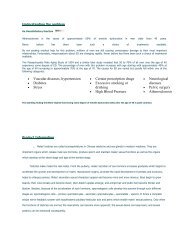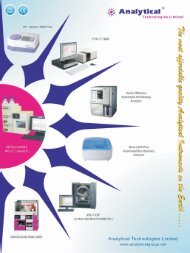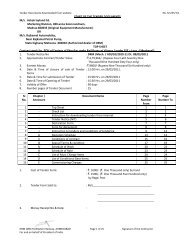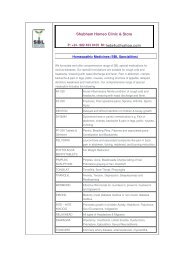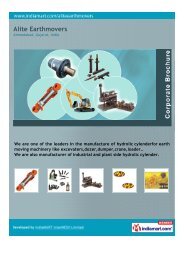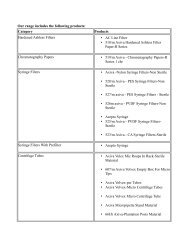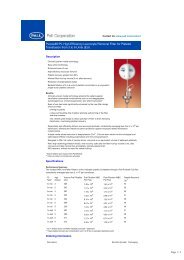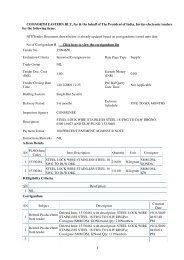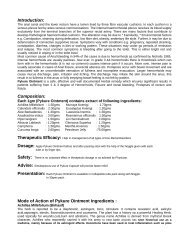Dydac offers wide range of Thyristor Power Controllers in ... - Imimg
Dydac offers wide range of Thyristor Power Controllers in ... - Imimg
Dydac offers wide range of Thyristor Power Controllers in ... - Imimg
Create successful ePaper yourself
Turn your PDF publications into a flip-book with our unique Google optimized e-Paper software.
<strong>Dydac</strong> <strong><strong>of</strong>fers</strong> <strong>wide</strong> <strong>range</strong> <strong>of</strong> <strong>Thyristor</strong> <strong>Power</strong> <strong>Controllers</strong> <strong>in</strong> S<strong>in</strong>gle Phase, Double<br />
Phase , Three Phase Star or Delta , Three Phase Star with Neutral .<br />
Features<br />
1. S<strong>of</strong>t start – bake out feature prevents moisture at start up<br />
2. Current Limit , Phase Loss Trip, Over temperature Trip<br />
3 Microprocessor Digital Programmable <strong>Thyristor</strong> <strong>Power</strong> Controller with Percentage<br />
Display. Program sett<strong>in</strong>g <strong>of</strong> Current Limit, S<strong>of</strong>t start etc by front keys<br />
Rat<strong>in</strong>gs<br />
1. S<strong>in</strong>gle Phase – 25 , 34, 59, 70, 90, 150, 200 , 250, 300 Amperes<br />
2. Double Phase – 25 , 34, 59, 70, 90, 150, 200 , 250, 300 Amperes<br />
3. Three Phase Star/Delta- 35, 50, 70, 90, 150, 200, 250, 300, 350, 400<br />
Ampers<br />
4. Three Phase Star with Neutral - 35, 50, 70, 90, 150, 200, 250, 300, 350,<br />
400 Amperes .<br />
<strong>Dydac</strong> Controls <strong>Thyristor</strong> SCR <strong>Power</strong> <strong>Controllers</strong> | A sample <strong>of</strong> some typical<br />
applications:<br />
· Large tank heat<strong>in</strong>g and mechanical relay replacement.<br />
· Therm<strong>of</strong>orm<strong>in</strong>g, textiles, <strong>in</strong>dustrial furnaces and ovens, extruders,<br />
kilns, chemical process heat<strong>in</strong>g, fast water heat.<br />
· Paper and pulp dry<strong>in</strong>g, packag<strong>in</strong>g mach<strong>in</strong>es, pharmaceutical processes,<br />
<strong>in</strong>frared ovens and dryers.<br />
· High-temperature ovens and furnaces, kilns, glass, ceramics & hightemperature<br />
alloys.<br />
· High-speed paper and <strong>in</strong>k dryers, high temperature IR heat<strong>in</strong>g, high<br />
temperature materials process<strong>in</strong>g.<br />
· Primary <strong>of</strong> transformer-coupled loads.<br />
· Phase angle proportional control. No temperature or power cycl<strong>in</strong>g<br />
· I2T Rectifier fuses standard<br />
· Isolated SCR's<br />
· Integrated thermal/mechanical design saves panel space<br />
· Voltage protection - MOV capacitance<br />
· 10 to 400 Ampere current rat<strong>in</strong>gs. Other Rat<strong>in</strong>gs Over 400 Amps Possible.<br />
· Easy to <strong>in</strong>stall, test, service<br />
The <strong>Dydac</strong> <strong>Thyristor</strong> <strong>Power</strong> Controller is a heavy duty, fully Digital or Analog<br />
one, two or three phase power control unit for controll<strong>in</strong>g the voltage applied<br />
to loads such as heat<strong>in</strong>g elements, thus, allow<strong>in</strong>g temperature control while<br />
elim<strong>in</strong>at<strong>in</strong>g contactor switch<strong>in</strong>g and over/under heat<strong>in</strong>g.<br />
The first <strong>in</strong> a series <strong>of</strong> Digital or Analog <strong>Thyristor</strong> ( SCR ) <strong>Power</strong> <strong>Controllers</strong><br />
<strong>in</strong>corporat<strong>in</strong>g protection functions.<br />
Built <strong>in</strong> switch<strong>in</strong>g methods are:<br />
1. Phase Control Fir<strong>in</strong>g<br />
2. Zero Cross<strong>in</strong>g Fir<strong>in</strong>g<br />
Range: 15 A - 400 A , 220-1200V,<br />
Advantages at a glance<br />
* Fully digital <strong>Thyristor</strong><br />
* Analog <strong>Thyristor</strong><br />
* Phase Control and Zero Cross<strong>in</strong>g<br />
* Current: 15 – 400 A (consult us when higher rat<strong>in</strong>gs are needed)<br />
* Voltage: 230- 500 V 50/60Hz<br />
* Cool<strong>in</strong>g Method: Forced air<br />
* Ambient. Temp: 0 - 50°C<br />
* Cont<strong>in</strong>uous Duty<br />
* One, Two or Three controlled phases<br />
* Three C.T.'s<br />
* Input 0-10VDC, 4-20mA or 0-20mA<br />
* Digital display<br />
LEDs<br />
* PLT * Over Current
* Over Temperature * Alarm * Trip<br />
Connection types<br />
* S<strong>in</strong>gle Phase<br />
* Double Phase<br />
* Three Phase Star without Neutral<br />
* Three Phase Star with Neutral<br />
* Delta Connection<br />
Protection functions<br />
* Under & Over current<br />
* Phase loss * Shorted SCR<br />
* Heat s<strong>in</strong>k over temperature Trip & Alarm<br />
* Internal failure<br />
The SCR control can deliver electrical power to heaters <strong>in</strong> several ways: phase<br />
angle fired, zero voltage switched and on/<strong>of</strong>f control.<br />
PHASE ANGLE FIRED<br />
These controls proportionally turn on a percentage <strong>of</strong> each power l<strong>in</strong>e half<br />
cycle. This gives smooth, <strong>in</strong>f<strong>in</strong>itely variable application <strong>of</strong> power to the<br />
heaters. Imag<strong>in</strong>e a light dimmer and how it provides power to a light bulb. This<br />
method will provide the most precise control <strong>of</strong> heaters. Phase angle fired SCR’s<br />
will respond the fastest to load change and provide maximum heater life. It is<br />
the most precise method <strong>of</strong> control. Phase angle fir<strong>in</strong>g can <strong>in</strong>crease heater life<br />
up to seven times depend<strong>in</strong>g on heater type. Phase angle fir<strong>in</strong>g also allows<br />
options such as s<strong>of</strong>t start, voltage limit and current limit. These options are<br />
not available with any other means <strong>of</strong> control.<br />
Equipment manufacturers and ma<strong>in</strong>tenance eng<strong>in</strong>eers need a reliable, flexible<br />
approach to controll<strong>in</strong>g electric-heat<strong>in</strong>g processes <strong>in</strong> today’s competitive, costconscious,<br />
<strong>in</strong>dustrial environment. And mak<strong>in</strong>g the right choices up front is<br />
vitally important.<br />
Let us help you Understand SCR <strong>Power</strong> Controls , compare <strong>Power</strong> Control Methods to<br />
make the right selection, and determ<strong>in</strong>e the type <strong>of</strong> Electrical enclosure you<br />
need.<br />
Graphs below shows phase angle fired voltage output on a 240V power l<strong>in</strong>e<br />
Graph shows 25% output or 60V RMS. Graph shows 50% output, 120V RMS<br />
Understand<strong>in</strong>g SCR <strong>Power</strong> Controls<br />
When select<strong>in</strong>g SCR <strong>Power</strong> Controls it is important to have a basic understand<strong>in</strong>g<br />
<strong>of</strong> how SCRs work. This will help you select the right SCR for your application.<br />
HOW SCR POWER CONTROLS WORK<br />
A silicon controlled rectifier (SCR) is a solid state switch<strong>in</strong>g device which can<br />
provide fast, <strong>in</strong>f<strong>in</strong>itely variable proportional control <strong>of</strong> electric power. Not<br />
only does this give maximum control <strong>of</strong> your heat process, but it can extend<br />
heater life many times over other control methods. S<strong>in</strong>ce the SCR is solid state,<br />
it can cycle on and <strong>of</strong>f over a billion times, if properly used.<br />
The advantages <strong>of</strong> SCR Controls over other temperature control methods<br />
· Improved response time.<br />
· Closer process control.<br />
· Extended heater life.<br />
· Reduced ma<strong>in</strong>tenance costs.<br />
· Silent operation. No arc<strong>in</strong>g and spark<strong>in</strong>g.<br />
· Reduced peak power consumption.<br />
Remember, a heat<strong>in</strong>g element is made <strong>of</strong> wire <strong>in</strong> most cases. If you use a<br />
mechanical relay to turn on your heater, it will cycle on or <strong>of</strong>f with<strong>in</strong> 30<br />
seconds or longer. The heater will expand and contract, gett<strong>in</strong>g more and more<br />
brittle each time. This is called thermal shock. Temperature overshoot may also<br />
occur. Relays also arc, spark and will burn out on a regular basis.
Mercury displacement relays can cycle from 3-15 seconds. While it controls<br />
better than a mechanical contractor, overshoot and thermal shock will still<br />
occur. If cycled too fast, Mercury relays can overheat and explode caus<strong>in</strong>g Haz-<br />
Mat problems<br />
Compar<strong>in</strong>g Different Methods <strong>of</strong> <strong>Power</strong> Control<br />
There are several methods commonly used to control power to electric heaters.<br />
Although some may seem “cheap and easy,” the total costs are not always<br />
considered.<br />
MECHANICAL RELAYS/CONTACTORS<br />
The up front cost for a simple relay is low on low power levels. As the power<br />
level goes up, the price rises. S<strong>in</strong>ce the mechanical relays will get dirty, arc<br />
and burn out, the relay has to be replaced every so many cycles. The labor cost<br />
associated with this is <strong>of</strong>ten overlooked. Due to the slow cycle time <strong>in</strong>herent<br />
for mechanical relays (30 seconds m<strong>in</strong>imum) control is poor, heated process may<br />
be damaged and heater life is shortened due to thermal shock.<br />
MERCURY DISPLACEMENT RELAYS<br />
(MDR) The up front cost <strong>of</strong> a mercury displacement relay, or MDR, is low at low<br />
power. The MDR can cycle faster than a mechanical relay, and will not burn out<br />
as quickly. MDR’s do have to be mounted <strong>in</strong> one direction. However, the MDR will<br />
explode if overheated due to cycl<strong>in</strong>g too fast, or if overpowered. This results<br />
<strong>in</strong> a Haz-Mat problem. Control is still poor compared with solid state devices.<br />
The heater is still receiv<strong>in</strong>g full l<strong>in</strong>e voltage for several seconds at a time.<br />
SOLID STATE RELAYS<br />
(SSR) The costs <strong>of</strong> low power Solid State Relays (SSRs), is also low. However,<br />
there are several cost factors forgotten about with SSRs. Common to all solid<br />
state devices, they generate heat and have to have heat s<strong>in</strong>ks. Also, SSRs<br />
generate more heat than SCRs due to their packag<strong>in</strong>g, and come without lugs that<br />
make a solid electrical connection for higher power levels. The MOVs and fuses<br />
needed for protection aga<strong>in</strong>st electrical shorts and spikes have to be customer<br />
<strong>in</strong>stalled. Aga<strong>in</strong>, this is a hidden cost. F<strong>in</strong>ally, when look<strong>in</strong>g at the SSR data,<br />
you must always DERATE THE DEVICE. Manufacturers <strong>of</strong> SSRs have derat<strong>in</strong>g curves<br />
published <strong>in</strong> their catalogs. However, please note that all SSRs are rated for<br />
the name plate power rat<strong>in</strong>g at 25ºC/77ºF ambient temperature. So a 50 Amp SSR is<br />
not good for 50 Amps if the temperature <strong>in</strong> the enclosure or work area is above<br />
25ºC/77ºF (how hot is your facility <strong>in</strong> July?). The s<strong>in</strong>gle surge current and<br />
voltage spike rat<strong>in</strong>gs are not as strong as an SCR. The SSR can cycle once a<br />
second and deliver better performance to both process and heaters than<br />
mechanical means. However, SSRs can only turn cycles on or <strong>of</strong>f.<br />
SILICON CONTROLLED RECTIFIERS<br />
(SCR) The costs <strong>of</strong> Silicon Controlled Rectifier (SCR) Controls, is higher at low<br />
power, but level out with other methods at mid to high power. All Avatar SCRs<br />
come equipped with proper heat s<strong>in</strong>ks, semi-conductor fuses and power lugs<br />
<strong>in</strong>stalled as an <strong>in</strong>tegrated package. With standard MOVs and DV/DT protection for<br />
l<strong>in</strong>e noise and voltage spikes, an SCR control can operate for decades. There is<br />
no rout<strong>in</strong>e ma<strong>in</strong>tenance to carry out. The level <strong>of</strong> control that can be achieved<br />
with a SCR is unatta<strong>in</strong>able with any other devices.<br />
Phase angle fir<strong>in</strong>g and zero voltage switched control <strong><strong>of</strong>fers</strong> 0.08 second response<br />
times on 60Hz power l<strong>in</strong>es. Heater life can be extended by 7 times. <strong>Power</strong> to<br />
heaters is <strong>in</strong>f<strong>in</strong>itely variable. S<strong>of</strong>t Start, Current Limit and Voltage Limit<br />
Options give advantages for controll<strong>in</strong>g heaters. S<strong>of</strong>t Start allows the use <strong>of</strong><br />
high <strong>in</strong>rush heaters. Current Limit gives control <strong>of</strong> high temperature elements<br />
for furnaces. Voltage Limit prevents temperature overshoot and extends heater<br />
life. Peak power is reduced, sav<strong>in</strong>g operators utility costs<br />
Electrical Enclosures and SCR <strong>Power</strong> Controls<br />
PROTECTING YOUR SCR CONTROLS FROM FAILURE<br />
Heat is the ma<strong>in</strong> enemy associated with SCR Control Failure. In fact, heat is the
ma<strong>in</strong> enemy <strong>of</strong> all solid state devices. Almost all semiconductors, <strong>in</strong>clud<strong>in</strong>g<br />
transistors, IC/s and thyristors (SCRs and TRIACs) will be destroyed at an<br />
<strong>in</strong>ternal junction temperature <strong>of</strong> 125ºC. Diodes can take a higher <strong>in</strong>ternal<br />
junction temperature (130-200ºC). This is one reason Avatar Instruments uses<br />
SCR-Diode comb<strong>in</strong>ations whenever possible.<br />
Heat is generated by voltage drops across a power device (SCR/TRIAC). This drop<br />
can be anywhere between 1 and 2 volts depend<strong>in</strong>g on the device. The more current<br />
(amps) put through the device, the higher the watts the device will dissipate <strong>in</strong><br />
the form <strong>of</strong> heat. This heat must be removed or the device will fail.<br />
All <strong>Dydac</strong> SCR Controls are designed to run at full rated amperage at 50ºC /<br />
122ºF ambient.<br />
Remember, you will need air <strong>in</strong>let and outlet holes with fan cool<strong>in</strong>g.<br />
F<strong>in</strong>ally, plastic enclosures act as an <strong>in</strong>sulator. You will most likely destroy an<br />
SCR control if you <strong>in</strong>stall it <strong>in</strong>side a plastic box. The only reliable way to use<br />
a plastic enclosure is to have a “thru-hole mount<strong>in</strong>g” style heat s<strong>in</strong>k, with the<br />
heat s<strong>in</strong>k’s cool<strong>in</strong>g fans outside <strong>of</strong> the box.<br />
Heater/Load<br />
Type Heater/Load<br />
Characteristics Control Type Typical<br />
Applications<br />
Constant Resistance Elements. Immersion heaters. Slow Response On/Off<br />
Zero Voltage<br />
Switched / Phase Angle Fired Large tank heat<strong>in</strong>g and mechanical relay<br />
replacement.<br />
Medium wave <strong>in</strong>frared, ceramic, cartridge, duct, strip, and band heaters.<br />
Platens. Faster response, Constant resistance heaters only. Phase<br />
Angle Fired or Zero Voltage Switched Therm<strong>of</strong>orm<strong>in</strong>g, textiles, <strong>in</strong>dustrial<br />
furnaces and ovens, extruders, kilns, chemical process heat<strong>in</strong>g, fast water heat.<br />
Open coil/wire heaters. Medium wave IR quartz. IR panels. Fastest, most<br />
precise response. Phase Angle Fired Paper and pulp dry<strong>in</strong>g, packag<strong>in</strong>g<br />
mach<strong>in</strong>es, pharmaceutical processes, <strong>in</strong>frared ovens & dryers.<br />
Silicon Carbide<br />
heaters. Load changes <strong>in</strong> resistance with age. High temperature elements.<br />
Phase Angle Fired with Current Limit Option High temperature ovens and<br />
furnaces, glass, ceramics and high temperature alloys.<br />
Tungsten (T-3) lamps and heaters. Short wave IR elements. Molybdenum heaters.<br />
High <strong>in</strong>rush currents<br />
High hot: cold resistance ration<br />
Tungsten 14:1<br />
Molybdenum 20:1<br />
Graphite: 20:1 Phase Angle Fired with S<strong>of</strong>t Start option High speed paper<br />
and <strong>in</strong>k dryers, high temperature IR heat<strong>in</strong>g, high temperature materials<br />
process<strong>in</strong>g.<br />
Transformer coupled loads. Primary driv<strong>in</strong>g. Inductive heater loads.<br />
Inductive loads. Phase Angle Fired with S<strong>of</strong>t Start option. Current limit<br />
option. Used with transformer-coupled heater loads to drive low voltage<br />
elements.<br />
<strong>Power</strong> Calculation<br />
When select<strong>in</strong>g the correct sized SCR power controller, rate the SCR for at least<br />
110% <strong>of</strong> the heater load. Heaters and power l<strong>in</strong>es have tolerances that can sw<strong>in</strong>g
on any given day or location.<br />
S<strong>in</strong>gle Phase<br />
WATTS÷ VOLTS= AMPS<br />
Example: 18,000W ÷ 240V = 75A<br />
AMPS x VOLTS= Watts<br />
Example: 60Ax 480V = 28,800W<br />
3-Phase<br />
WATTS÷ VOLTS÷ 1.73 = AMPS<br />
Example: 18,000W ÷ 240V = 75 ÷ 1.73 = 43.35 A<br />
AMPS x VOLTS x 1.73 = Watts<br />
Example: 60A x 480V x 1.73 = 49,824W



